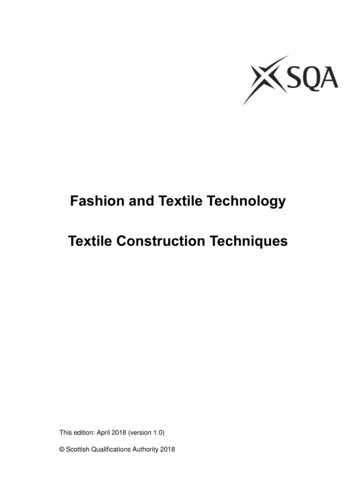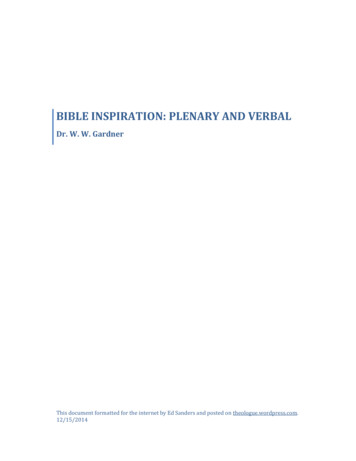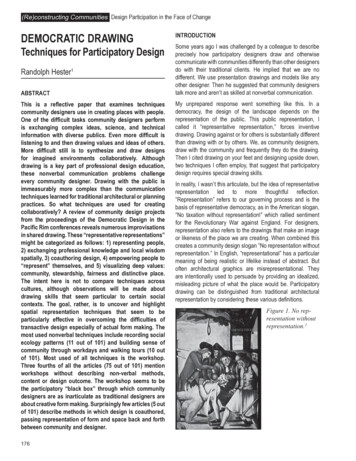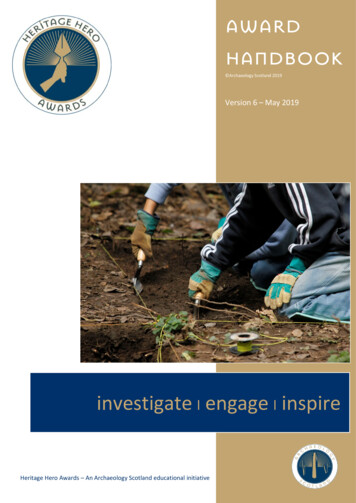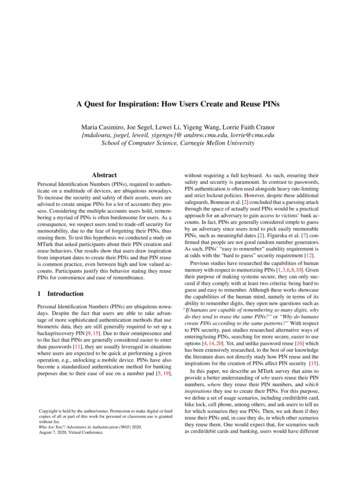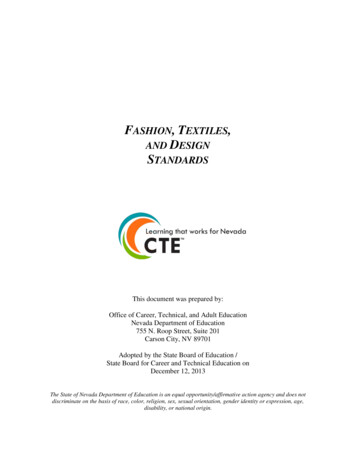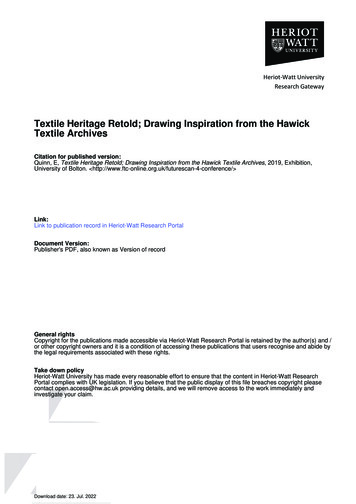
Transcription
Heriot-Watt UniversityResearch GatewayTextile Heritage Retold; Drawing Inspiration from the HawickTextile ArchivesCitation for published version:Quinn, E, Textile Heritage Retold; Drawing Inspiration from the Hawick Textile Archives, 2019, Exhibition,University of Bolton. ce/ Link:Link to publication record in Heriot-Watt Research PortalDocument Version:Publisher's PDF, also known as Version of recordGeneral rightsCopyright for the publications made accessible via Heriot-Watt Research Portal is retained by the author(s) and /or other copyright owners and it is a condition of accessing these publications that users recognise and abide bythe legal requirements associated with these rights.Take down policyHeriot-Watt University has made every reasonable effort to ensure that the content in Heriot-Watt ResearchPortal complies with UK legislation. If you believe that the public display of this file breaches copyright pleasecontact open.access@hw.ac.uk providing details, and we will remove access to the work immediately andinvestigate your claim.Download date: 23. Jul. 2022
Futurescan 4: Valuing PracticeUniversity of Bolton, UK23rd-24th January 2019ABSTRACTS & BIOGRAPHIES
Futurescan 4: Valuing Practice23rd-24th January 2019University of Bolton, UKFashion and textiles practice intersects traditional processes and innovative technologies. Tacit knowledgeacquired through hand skills, making, utilising equipment and working with processes is fundamental todeveloping understanding. Although practical learning is valued, the teaching of creative and making subjectsis under threat in formal education. Within the fashion and textile industries there are skills shortages.Heritage crafts risk being lost as digital technologies and automation impact upon future generations.The Association of Fashion & Textile Courses (FTC) conference Futurescan 4: Valuing Practice, provides aninternational forum for the dissemination of research, creative practice and pedagogy surrounding fashionand textiles. Contributions from established and early career researchers, postgraduates, practitioners,makers and educators regarding completed projects or work in progress under the following topics: Valuing Artisan Skills, Drawing and MakingLearning from History, Tradition and IndustryCollaborating and Cross-disciplinary WorkingIntegrating and Connecting Digital TechnologiesDesigning Responsibly and Working SustainablyPromoting Diversity, Employability and CommunityInvestigating Creative Processes and PedagogyThe conference includes keynote speaker presentations, full papers (20-minute presentations), short papers(10-minute presentations) and examples of practice-based work.Association of Fashion and Textile Courses (FTC)The Association of Fashion and Textile Courses (FTC) was formed in 1977. Today, the FTC exists as a subjectassociation to promote and develop fashion and textiles through academic debate, education and research.Through its networks, the FTC has extensive links with industry, public and professional bodies and acts toadvise on quality in educational matters nationally and internationally.For further information see: www.ftc-online.org.uk@FTCorg#futurescan4
CONTENTSKEYNOTE SPEAKERS4A1 Learning from History, Tradition and Industry8B1 Investigating and Explicating Creative Processes13C1 Valuing Artisan Skills, Drawing and Making17D1 Designing Responsibly and Working Sustainably22C2 Valuing Artisan Skills, Drawing and Making26A2 Learning from History, Tradition and Industry31C3 Valuing Artisan Skills, Drawing and Making36F1 Collaborating and Cross-disciplinary Working40G1 Integrating and Connecting Digital Technologies44C4 Valuing Artisan Skills, Drawing and Making48E1 Promoting Diversity, Employability and Community52B2 Investigating and Explicating Creative Processes57D2 Designing Responsibly and Working Sustainably62C5 Valuing Artisan Skills, Drawing and Making65A3 Learning from History, Tradition and Industry69F2 Collaborating and Cross-disciplinary Working74C6 Valuing Artisan Skills, Drawing and Making79EXHIBITS: Learning from History, Tradition and Industry82EXHIBITS: Collaborating and Cross-disciplinary Working86EXHIBIT: Valuing Artisan Skills, Drawing and Making92EXHIBITS: Integrating and Connecting Digital Technologies100EXHIBITS: Investigating and Explicating Creative Processes101EXHIBITS: Designing Responsibly and Working Sustainably103PRESENTER BIOGRAPHIES104
KEYNOTE SPEAKERKAREN NICOLTextile Designer/Artist, Honorary Fellow RCA, Artist in Residence De Montfort UniversityHonorary Fellow of the Royal College of Art, Karen Nicol is an embroidery and mixed media textiledesigner/artist with a design business working in fashion, interiors and gallery, based in London. Inthe fashion world Karen has worked and collaborated with design houses including Schiaparelli,Alexander McQueen and Louis Vuitton. Her work covers both ready-to-wear and couture, creatingdesigns, developing concepts, catwalk garments and production. The King of Qatar, the Pope, EsteeLauder and Gwyneth Paltrow have been amongst many clients commissioning her work for interiors.Screens for palaces, tableware for parties, upholstery fabrics and rugs. Karen has also producedown label collections for companies such as Anthropologie and Designers Guild.Karen’s aim, throughout her long career, has been to break boundaries in conventional fabricembellishment and to push the preconceived expectations of embroidery. Most of her work isproduced on a hand governed embroidery machine whose basic simplicity allows hands oninnovation and huge diversity. In 2010 Karen began to create art pieces to explore and develop herpassion for the infinite possibilities of embroidery without the restricting practicalities necessary infashion and interiors. She creates large embroidered and sculptured animals as vehicles for hertextile explorations ‘Couture Creatures’ . Napoleonic Polar Bears to Marquetry foxes. Karen hasexhibited in galleries and art fairs around the world, with solo shows in London, Paris and New York.Currently her three-year role as artist in residence at De Montfort University opens up new, excitingopportunities to mix the knowledge and practical skills gained from a hugely varied 40 years ofpractice with further exploration of modern technology. Karen was founder, senior lecturer andvisiting professor of the Mixed Media MA degree course at the Royal College of Art, London and hastaught and lectured in colleges around the world. In November 2015 she was made an RDI, a RoyalDesigner for Industry, by the Royal Society of Arts.4
KEYNOTE SPEAKERKATE HILLSFounder Make it British, Organiser Make if British Live!Kate Hills is the founder of Make it British, a platform to help UK manufacturers and British-madebrands find more customers.Founded in April 2011 as a way of supporting British brands that manufacture their products in theUK, Make it British originally started as a blog, but has now grown to include a British brandsdirectory as well as features on British craftsmanship and a resource for designers wanting to findmanufacturers to make their products.Kate also runs the manufacturing trade show Make it British Live! which attracts over 5,000 visitorsfrom 17 different countries, all looking to make their products in the UKNow in its sixth year, the next event takes place in May 2019 at the Business Design Centre inLondon.5
KEYNOTE SPEAKERANNE BODDINGTONProfessor Design Innovation, Pro Vice Chancellor Research, Business & Innovation,Kingston University; REF 2021 Sub Panel Chair for Art & Design: History, Practice & TheoryProfessor of Design Innovation, Anne Boddington, is Pro Vice Chancellor for Research, Business &Innovation at Kingston University. Educated as an architect, an urbanist and subsequently as acultural geographer, she has extensive experience of independent governance, over thirty years inleadership and management experience in higher education, nationally and internationally,spanning teaching, research, business and civic engagement with particular expertise inarchitecture, art, design and humanities. She is currently Sub Panel Chair for Art & Design: History,Practice & Theory for the U.K.’s Research Excellence Framework (REF) 2021.6
KEYNOTE SPEAKERLOU DALTONMenswear Designer, Founder Creative Director of Lou DaltonLou Dalton’s ethos is simple: brilliantly made clothing for men with an emphasis on authentic,enduring design.Having left school at the age of 16 to become an apprentice for a bespoke tailor, Lou went on tostudy at the Royal College of Art, graduating in 1998. Since launching her eponymous label in 2008,her work has been defined by a hands-on precision and an instinctive flair for cut and fabric.Lou’s clothing is contemporary yet timeless, drawing upon the traditions of British craft and thenarratives of her Shropshire roots in a way that is forward thinking and modern; never nostalgic.The garments are functional and understated at their core but immediately eye catching in theirunbeatable quality and ability to elevate the wearer; a subtly impressive trait unique to all of Lou’sdesigns that she sums up as “quiet noise.”With over two decades in the industry, Lou is one of the most experienced and skilled designersworking in men’s fashion today. Her long list of global clients and collaborators includes Grenson,Jaeger, an ongoing collaboration with knitwear specialists John Smedley and a new collaborationwith Gloverall for AW19.7
ABSTRACTA1 Learning from History, Tradition and IndustryMoving the Bust Dart: The Fashion Designer, Sylvia Ayton’s Relationship with Pattern CuttingDR. KEVIN ALMOND, University of LeedsThe research explores the work and career of fashion designer, Sylvia Ayton (MBE) and her relationshipwith the craft of pattern cutting. Ayton graduated from Professor Janey Ironside’s fashion school, at theRoyal College of Art, London, in 1960. In her autobiography, Ironside noted, “One of the best results of thesocial revolution in Britain since the Second World War has been the release of many young designers tothe world, whose potentialities would have been wasted before the war” (1973, p.113). Ayton’s careerevolved during this social revolution and is significant because of its flexibility and longevity. She workedas a designer in business partnership with textile designer, Zandra Rhodes, in the 1960s and as acommercial designer for a UK high-street retailer, from 1969 to 2002. This study will allow privileged accessto her work archive, and will trace Ayton’s involvement with pattern cutting throughout her careerconsidering her experiences as a designer/pattern cutter for different markets. A review of the literatureshows that pattern cutting has rarely been explored through the relationship of the designer with the craft,particularly designers such as Ayton who have worked anonymously for large companies or retailers. Theunderpinning research will bridge this gap by investigating the thinking, practices and paradigms of patterncutting during a fashion designer’s career. It will also help to identify a lasting reference point for the fusionof technology with design, expressed in the context of fashion design careers within the global fashionindustry.8
ABSTRACTA1 Learning from History, Tradition and IndustrySwimwear, Skin and the Modern SurfacePAM BROOK, Bradford College/Nottingham Trent UniversityWorking in collaboration with the archivist at John Smedley Limited and photographing their smallcollection of interwar swimwear three dimensionally on a mannequin, it became apparent that some ofthe cream-coloured bathers would have a nude appearance on the body. The introduction of ‘Jaylax’, arubber core elastomer thread, into the knitting increased the sheath-like qualities of the garment. Thisbuilt on the assertion of Symington Ltd of Leicester in their late 1930s marketing that their patentedtelescopic swimsuit would fit like a ‘mermaid’s’ skin. The purpose of the paper is to explore the modernistswimsuit as a 'second skin'.The modernist aesthetic in the design of swimwear complemented the denuded modern surface in thebuilt environments in which they were worn, including lidos, hotels and ocean liners. During the 1930scompanies such as Symington Ltd and John Smedley Ltd competed to perfect their versions of the garmentboth aesthetically and technically to fit the body like a second skin.The concept of second skin or ‘skin’ and ‘swimwear’ as an expression is currently in use in the developmentof Speedo’s new ‘fast skin’ range.Using skin theorists such as Anna Anlin Cheng, Didier Anzieu and Stephen Connor this paper explores thesetechnical and aesthetic developments in relation to the modernist surface and locale.9
ABSTRACTA1 Learning from History, Tradition and IndustryFashion - Making a Discipline in the Making?SUSAN CRAIG, Manchester Metropolitan UniversityDAVID LEATHLEAN, Manchester Metropolitan University‘All designers should absorb The Zeitgeist: art, literature, popular culture and products, architecture,electronics and interior design – all can be seen to influence contemporary fashion, and vice-versa’. Fox,2012 (cited in Leach, 2012)It is generally recognized that knowledge of creative processes is of relevance to design students, in thefields of fashion and textiles. We contend that knowledge of history, tradition, and past and presentindustrial practices is vital to the wider context of fashion studies, and equally relevant for fashionpromotion and buying students at undergraduate and postgraduate level.Constraints imposed by the current fee structure, by the speed of technological change, and by thedisconnect in students’ perception of education and assessment, has led to excessive focus on assessmentoutcomes at cost to deep understanding of the fashion industry, leading to gaps in both skills andexpectations (Riley, 2017).Only a limited number of students on design courses will proceed to careers in design. Many will work inthe fashion industry, perhaps in buying or promotion, or at the very least interacting with teams in relationto such functions. The development of cultural capital is essential to develop the knowledge that will allowstudents to progress into various fashion industry roles, with positive implications for employability(Camps et al, 2016).The fashion industry, although creative, demands interpretation and reinterpretation of past styles andideas. These are the drivers of innovation and momentum in fashion, but are only possible through aknowledge of tradition, history, styles and colours acquired through students' embedded learning andpersonal development.Learning and teaching also has to respond to fashions’ impact on society and the environment. Awarenessof historical context and innovative production processes is essential to achieve sustainability and otherbest practices. Through case studies of fashion buying and promotion students, we shall argue for thecross-curricula relevance of what is traditionally considered to be design-specific knowledge.References:Camps, J., Oltra, V., Aldas-Manzano, J., Buenadventura-Vera, G. and Torres-Carbalo, F. (2016) “IndividualPerformance in Turbulent Environments: The Role of Organizational Learning Capability and EmployeeFlexibility.” Human Resource Management, 55(3) [Online] [Accessed on 28.06.18] oi/full/10.1002/hrm.21741Cowan, J. (1998) On Becoming an Innovative University Teaching: Reflection in Action. SHRE and OpenUniversity Press: Buckingham.Laurillard, D. (1994) Rethinking University Teaching a framework for the effective use of educationaltechnology. Routledge: London.Leach, R. (2012) The Fashion Resource Book. London, Thames & Hudson.Riley, T. (2017) “Work-based learning for the creative industries: A case study of the development of BA(Hons) web design and social media.” Higher Education, Skills and Work-Based Learning, 7(1) pp.79-91.10
ABSTRACTA1 Learning from History, Tradition and IndustryA Practice Based Methodology for Research in the ArchiveGINA PIERCE, University for the Creative Arts FarnhamMy research focuses on the fabric samples and documentation held in the archive of the furniture companyParker Knoll Ltd, part of the Frederick Parker Collection. This archive is an under researched and undertheorised resource, particularly in a creative context. The anonymous and neglected fabric samples areunknown to the textile community and I will be undertaking the first critical study.The aim for this practice based research is to create material responses to the archive in the form of the‘interpretative object’ that reveals and explores the context of the fabric samples’ design, selection andmanufacture. Here connections between the archive and the audience can be reflected upon to formulatea new model of pedagogical use of an archive both in design education, and with different social andcommunity groups.My research proposes an intention to explicitly act as an intermediary or transitionary tool to inspire aselected participatory group into a guided activity. The project work undertaken will be reflected upon asto the success or otherwise of the models used for furthering the use of the archive as an educationalmethodology.11
ABSTRACTA1 Learning from History, Tradition and IndustryThe changing relationship between Yorkshire fashion consumers and their clothing in the 20th CenturyELAINE EVANS, University of LeedsThe research explores preliminary work conducted for an extended research project that investigates howattitudes towards the quality and quantity of clothing possessions, their length of active service and theirdisposal has changed over the course of the 20th Century. This phase of the study utilises the YorkshireFashion Archive, housed at University of Leeds, as a resource to examine clothing and social history withinthe Yorkshire region in the 20th Century, and the value of the relationships between clothing and thewearer. The emotional connections to particular items of clothing are examined through interviews withdonors and the oral histories connected to donated items. An object-based research approach is adoptedto analyse a selection of the handmade and mended clothing from the archive. In an area such as Yorkshirewith a rich textile heritage, the material objects and oral histories connected to them give a wealth ofinformation about the lives of Yorkshire people in the 20th Century. This permits an analysis of the changesin the skill base in the region, both in commercial manufacture and the making of clothing in the home aswell as consumers’ shifting attitudes towards the clothes they chose to wear themselves.12
ABSTRACTB1 Investigating and Explicating Creative ProcessesBiomimicry using Embodied Materials in Paper Making WorkshopsDR. JULES FINDLEY, University of BrightonEmbodied materiality in my research was used as an investigation into the relationships between the affect ofgrief and the creative, embodied encounters with paper materials. In some types of traumatic loss, complicatedgrief can subsume the bereaved in a way like no other.The research integrated creative practice, working with fibre-based materials, with the scholarly and culturalexploration of the literature and theory of mourning as a specific psychological state of mind. It was anexploration of the experience of mourning a complicated grief, through the sustained process of an embodiedencounter with the materiality of making paper. Paper became the metaphor to discuss research questions thatconnected the maternal with affect in grief and the body that inputs Cartesian culture is feminised using affectof the embodied encounter with materials. The research was not into art therapy.Using workshops in paper making, I was able to teach a module on fibre-based biomimicry to students to reflecton the relationship between materiality and affect. In making the substrate, I use the methodology of play;judgment is suspended, whilst the paper is being handmade to create individual materiality. Students learn tomake paper and take their samples from the workshops home to hone their techniques, making more paperand reflecting on their new skills in their research blogs. This confirmed the space for the studio as the domestic,and the range of techniques from the students learning and my feedback fed into my learning and back out tothe students again, fulfilling a circular feedback loop of educational and methodological techniques andreflection in the students and my research.Keywords: Handmade, Paper, Biomimicry, Embodied Materiality, Substrate13
ABSTRACTB1 Investigating and Explicating Creative ProcessesDynamic Cutting: a new method of experimental pattern cutting using metaphor to activate tacitknowledge of material creativity and spatial creativityDONNA SGRO, University of Technology SydneyThis creative practice research was conducted as part of my PhD by project at RMIT University. The valuesembedded in practices of fashion design are becoming better understood through research that is basedin creative practice and undertaken by practitioners. In my experience as a fashion designer, the separationof design and pattern cutting in my practice impacted creativity in the cut of garments. This research aimedto expand creativity through pattern cutting by challenging this separation formed through my tacitknowing in practice. A metaphoric strategy was explored to adapt new methods for design from a study ofbutterfly metamorphosis. In this study, research for design was undertaken using mixed methods includinggrowing butterflies, documentation, drawing and text-based analysis from a variety of disciplines on thesubjects of butterflies and metamorphosis. Generative metaphors developed from this study of butterflymetamorphosis provided an alternative conception of a garment in the design process for pattern cutting.First, the garment was conceived as a transitioning insect body, then as a dynamic form, lastly as a chrysalisformation. This series of metaphors led experimentation in research through design of garments andtextiles, resulting in two new concepts to describe creativity in pattern cutting using tacitknowledge. Material creativity refers to the creativity a practitioner experiences when designing andmaking garments through individual engagement with materials. Spatial creativity refers to the creativitya practitioner experiences when working with and analysing patterns in both 2D and 3D forms. DynamicCutting is a new method of experimental cutting for fashion design, which involves attuning to bothmaterial and spatial affordances. This research offers a new framework for thinking through, reflectingupon and expanding notions of creativity in fashion design using tacit, hand-based engagement withpattern cutting. It also demonstrates how a metaphoric strategy can be used to raise awareness of, andextend the application of, implicit knowing in practice.14
ABSTRACTB1 Investigating and Explicating Creative ProcessesSpatial definers in surface pattern design – introducing alternative design variables as tools in thetextile design process*TONJE KRISTENSEN JOHNSTONE, University of Borås, SwedenWithin the field of textile design, the understanding of surface patterns is fundamental knowledge and asomewhat specific professional skill. The purpose here is to report on experiments explicitly introducingabstract spatial definers, such as “above”, “behind” etc., in the textile design process as basic surfacepattern variables.This idea was tested out in student workshops on four different European art and design universities duringa period of three months. The primary focus of the workshops was to test surface patterns as spatialdefiners, by introducing a design variable that answers the question “what is the pattern doing as a spacedefiner?”.The results of the workshops demonstrated a potential of using conceptual spatial determinations asdesign variables, as the design solutions were clearly influenced by the introduction of these variables. Inaddition to adding to the knowledge of the field, the results can be used by designers who seek alternativeworking methods, or as material for reflection and inspiration when teaching surface pattern design indesign education programmes.Using workshops in teaching is a means of gaining valuable insights and learning in creative practice.Transforming this knowledge into teaching methods and pedagogical tools would allow methods and ideasto be re-thought, and unconventional ways of surface pattern design thinking to be explored. This papercontributes to the development of design methods and provides an alternative perspective on surfacepattern design. It also highlights a small area that is rarely in focus in textile design research.15
ABSTRACTB1 Investigating and Explicating Creative ProcessesDeveloping pedagogical tools for designing with invisible materialities through experimental designresearchJYOTI KAPUR, University of Borås, SwedenDR. MARGARETA ZETTERBLOM, University of Borås, SwedenUsually we perceive textiles in our surroundings consciously through vision and touch. Designing theperception of space through textiles by using invisible materialities would essentially mean challenging ourvisual and haptic perception. The pedagogical tools for the creative process of designing textiles forinvisible materialities like smell and sound in this paper, is explored through experimental design researchmethods. Through planned workshops with students from bachelor and master studies in textiles, fashionand spatial design, we plan to explore how sounds and smells of a space become design materials fordesigning textiles that define a space. Knowledge which can be used in the development of a curriculumfor new kinds of textile design courses focusing on how sound, smell, touch and vision can play a majorpart in the design of textiles.The workshops are conceptualised to foster speculative approach whenexploring materials, methods and ways of articulation through multi-modal techniques such as soundrecording, film, photography and textile sketching. As an initial step the participants walk blindfoldedthrough space to be able to focus on and investigate its dynamic nature by their auditory and olfactorysenses. In progression, they investigate the phenomenon of invisible materialities being changed either byabsorption, diffusion, reflection, or refraction when adding textile textures and suspended textile forms inspace. Using this experimental set-up the students are asked to present their ideas as textile-sketches inscale 1:1 specific for the space using smells and sounds as design drivers. By altering the ambient conditionsof a space such as temperature, moisture and airflow, another layer of patterning could be added to thedesign expressions. Expected outcomes of the workshops as new pedagogical tools are explorations andspeculative sketchy ideas suggesting for novel textile design methods through smells and sounds as designdrivers.16
ABSTRACTC1 Valuing Artisan Skills, Drawing and MakingAn experiential investigation into the embroidery practices of the Chernobyl BabushkaCLAIRE A BAKER, Northern School of ArtThis paper contextualises and personalises a cohesive and cogent line of enquiry into the textile practicesof an obsolescent community, the Self-Settlers or Babushkas (шка- grandmother or old woman in Russian)of Chernobyl, through empirical research: observing, recording and gathering testimonies and histories inthe field. Chernobyl, as Place (or rather non-Place) is the site of the world’s worst nuclear accident of 1986and is where;the process of remembrance continues to activate the past as something, which is lived and acted,rather than represented. (Dean and Millar, 2005, p.14)Post-accident 91,200 people were evacuated from areas around Chernobyl which are now deemed to beuninhabitable. However, 136 remain, their legacy the declining remains of a forgotten community, and aloss of tradition and culture, including their strong textile heritage which is dying out with them.The ‘Embroidery as a Language’ project was implemented in order to discover how a common interest –embroidery, could be used to encourage stronger personal connections within the context of actionresearch methodology. The discovery of the essentiality of its conservation was of deep significance.Alongside building an archive, the preservation of their history through personal experiences andnarratives is paramount, and this paper reflects the focus on the self-settlers (those who returned to theirhomeland after being evacuated and dispersed due to the nuclear disaster) and their embroideries, as anon-going initiative and an experiential poignant investigation that has developed over the past four yearsand during a number of visits to the exclusion zone. By critically analysing the findings, and personallyexperiencing the difficulties in the daily lives of the Babushkas, witnessing their fight for survival and thecritical role embroidery plays in their dying culture, the resulting conclusions include the personalexperiences of the Babushkas of Chernobyl who have created stitched decorative textile outcomes in astyle typical of their region, as well as the part embroidery has played in their lives, historically and in thepresent.Furthermore, it is questioned: How does the location and current lifestyle of the Babushka affect thecontinuance of their regional, traditional, rural craft?17
ABSTRACTC1 Valuing Artisan Skills, Drawing and MakingA pedagogical approach to creative copying from photographic imagery: A drawing-led practice-basedresearch inquiryMARK PARKER, Heriot - Watt University(Presenting: SARA KEITH, Heriot - Watt University)I am a textile designer and academic with extensive experience of both workin
designer/artist with a design business working in fashion, interiors and gallery, based in London. In the fashion world Karen has worked and collaborated with design houses including Schiaparelli, Alexander McQueen and Louis Vuitton. Her work covers both ready-to-wear and couture, creating

